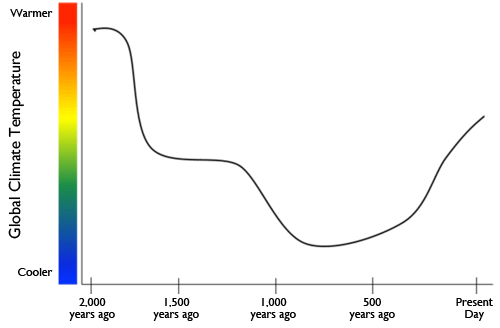Climate Change Evidence: Pollen in Core Samples—Our Results
Pollen from the dominant plants in a region travels through the air and falls everywhere, including into bodies of water such as lakes. There, the pollen settles to the bottom and accumulates along with the lake-bottom sediments. The climate of a region during a specific time period can be determined by the type of pollen found in those sediments, whether the pollen is from warmer-weather plants or colder-weather plants.
We used pink, green, orange, and blue modeling clay to create a model of sediments and pollen deposited in a lake or pond over time. Once our four-layer model was done, we used a small plastic or metal pipe to take a core sample by pushing the pipe straight down through all of the layers. We then pulled the pipe back up, but our sample was stuck in the pan. We tried again, in a different location in the model; by turning the pipe, we were able to successfully pull up a core sample that stayed inside the pipe. We used a wooden dowel or stick to push the core sample out of the pipe. We then measured the thickness of each layer of sediment in the sample. Our measurements were as follows:
|
Layer |
Color |
Thickness |
|
Layer 1 (top) |
pink |
0.8 cm |
|
Layer 2 |
green |
0.3 cm |
|
Layer 3 |
orange |
0.7 cm |
|
Layer 4 (bottom) |
blue |
0.2 cm |
 |
We assumed that each centimeter of clay represented 1,000 years of time. Our core sample was 2.0 cm thick. Given that 1 cm represented 1,000 years, the total time represented by our core was 2,000 years. Based on the thickness of each layer, we determined the number of years represented by each layer as follows:
|
Layer |
Color |
Thickness |
Years represented |
|
Layer 1 |
pink |
0.8 cm |
800 |
|
Layer 2 |
green |
0.3 cm |
300 |
|
Layer 3 |
orange |
0.7 cm |
700 |
|
Layer 4 |
blue |
0.2 cm |
200 |
Each color of clay represented a sedimentary layer containing pollen from specific plant species; the plant species indicated the type of climate during that time. Before starting the activity, we decided that the different colors of clay represented sediments containing the following types of pollen:
|
Clay color |
Types of pollen in sediments |
|
Pink |
mostly spruce and alder pollen, with a little oak and grass pollen |
|
Green |
pollen from cold-climate plants, such as spruce and alder trees |
|
Orange |
mostly oak and grass pollen, with a little spruce and alder pollen |
|
Blue |
pollen from warm-climate plants, such as oak trees and grasses |
The top of the core represented the present based on the law of superposition—the first layer deposited is the oldest and the top layer is the youngest. Based our data, we determined that the oldest layer (blue—layer 4) contained pollen from grasses and oaks, which indicated a warm climate. This layer represented a time from about 2,000 years before the present time to about 1,800 years before the present. Layer 3 (orange) represented the time period from about 1,800 years before the present to about 1,100 years before the present. In this layer pollen from oak trees and grasses was still predominant, but pollen from alder and spruce trees also was present. This indicated that the climate had cooled somewhat relative to the time when the blue layer was deposited.
Oak and grass pollen was absent from layer 2 (green), indicating a further cooling of the climate during the period between 1,100 years before the present and 800 years before the present. The top, youngest layer (pink) mostly had pollen from the cold-climate plants (spruce and alder), but it also had a little pollen from oak trees and grasses. This implied that the climate began to warm again after 800 years before the present, with the warmer climate continuing to the present.
We created the following graph to show the approximate progress of the temperature change over 2,000 years:

This content has been re-published with permission from SEED. Copyright © 2025 Schlumberger Excellence in Education Development (SEED), Inc.

